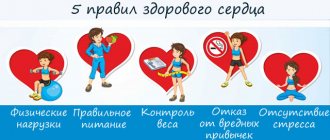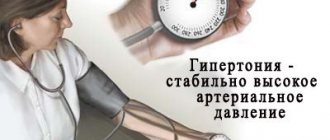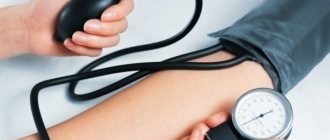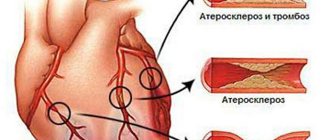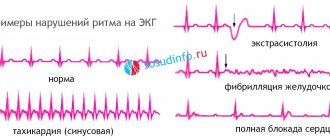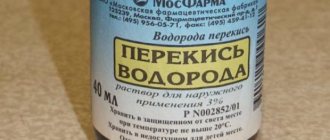Menopause is the beginning of the aging of the body.
For women, it is primarily associated with menopause, caused by the decline of ovarian function. Typically this process begins at 45-55 years of age.
However, under the influence of negative factors, the numbers can change both up and down.
According to statistics, about 40% of women experience pressure surges during menopause. The appearance of this symptom is due to various factors. In particular, hormonal changes.
Letters from our readers
Topic: Grandma's blood pressure has returned to normal!
From: Christina ( [email protected] )
To: Administration otgipertonii.ru
Christina, Moscow
My grandmother’s hypertension is hereditary - most likely, I will have the same problems as I get older.
I accidentally found an article on the Internet that literally saved my grandmother. She was tormented by headaches and had a repeated crisis. I bought the course and monitored the correct treatment.
After 6 weeks she even started talking differently. She said that her head no longer hurts, but she still takes pills for blood pressure. I am sending a link to the article
How does menopause affect blood pressure?
When age-related changes begin, the female body ceases to produce sex hormones in sufficient quantities. Estrogens and progesterone play an important role in maintaining cardiovascular health. A deficiency of both types of hormones leads to vasoconstriction, which causes fluid retention in the body.
The accumulation of water in tissues is the main factor that provokes an increase in blood pressure during menopause in women. The secondary ones include:
- cardiovascular diseases;
- lack of physical activity;
- excess weight;
- presence of bad habits;
- unbalanced diet;
- hereditary predisposition;
- a sharp increase in cholesterol levels;
- kidney pathologies;
- emotional and physical stress.
Long-term studies have shown that in many cases, high blood pressure during menopause is not a pathology, but a normal age-related change.
Folk remedies
To normalize high blood pressure during menopause in women, traditional medicine recommends hawthorn, sage, red clover, and some herbal remedies. They are used in complex treatment along with traditional drugs.
If hypertension is present during menopause, then traditional healers often recommend hawthorn as a means to strengthen the heart muscle and normalize the functioning of the vascular system. The following medications are used:
- A decoction of hawthorn flowers, dried herbs, and motherwort. For it, take equal parts of herbs, chop them, pour in 1 tsp. 250 ml water. Boil for 3 minutes. This volume is drunk per day in three doses. Take 30 minutes after meals.
- Infusion of fruits. You need to take 2 tbsp. l., pour 250 ml of boiling water into a thermos. Leave for 40 minutes, take 1/3 cup three times a day.
- Pharmacy tincture of hawthorn. Forty drops are diluted in 100 ml of water, drunk 3 times a day after meals.
Herbalists recommend the juice of sage stems. This remedy is obtained from fresh stems and is only available in the summer. Drink 2 tbsp. l. three times a day after meals.
An infusion of dried hawthorn flowers, mistletoe leaves, peppermint, and motherwort herb can be obtained at any time of the year. Take all the ingredients in equal proportions, grind them, then pour boiling water (1 tbsp per 200 ml). Boil for 3 minutes, leave for 40 minutes, cool, filter. Drink 100 ml three times a day after meals.
See also: Which fruit lowers blood pressure?
If menopause and blood pressure go together, then red clover decoctions will be beneficial for the functioning of the brain and heart. For the decoction, take 2 tbsp. l. flowers of the plant, pour 250 ml of boiling water, simmer in a water bath for 10 minutes, then cool, strain. The resulting medicine is taken four times a day, 50 ml.
Will hypertension go away after menopause?
The menopausal period is divided into three stages:
- premenopause - begins when the usual menstrual cycle goes astray and lasts until the last menstruation;
- menopause - the first year after the cessation of menstruation;
- Postmenopause is the final stage that lasts until the end of life.
Women experience increases and decreases in blood pressure during menopause already at the first stage. If you pay close attention to your health during this period, you can avoid the development of chronic hypertension or hypotension. However, your usual blood pressure readings may change slightly forever.
Don't tolerate high blood pressure
Now hypertension can be cured by restoring blood vessels...
>
Hypercorticism (Itsenko-Cushing disease and syndrome)
Hypercortisolism is a combination of symptoms caused by the long-term influence of corticosteroids (hormones of the adrenal cortex) on the human body. The cause of increased secretion of these hormones may be a neoplasm of the pituitary gland (Itsenko-Cushing disease), a neoplasm of the adrenal cortex (Itsenko-Cushing syndrome), hyperplasia of the adrenal cortex, hormonally active tumors of other localizations, as well as the systematic use of steroid hormones.
The most striking manifestation of hypercortisolism is a characteristic change in a person’s appearance. Such people are overweight, with fat deposited mainly in the abdomen, chest, neck, and face. At the same time, the limbs, on the contrary, “lose weight.” The face is rounded. The skin of the cheeks, chest and back becomes purple-bluish in color. The skin is prone to dryness, the skin is thinned, easily injured, and subcutaneous hemorrhages appear. A venous pattern appears clearly on the chest and limbs. Wide stripes appear on the stomach, shoulders, hips, and chest - stretch marks resembling “tongues of flame” of red-violet color. In areas of friction on the skin, areas of hyperpigmentation (darkening) appear. Characterized by pustular skin lesions, excessive body hair growth, and hair loss on the head.
Arterial hypertension in patients with hypercortisolism occurs in 75-80% of cases and is a constant and characteristic symptom. Steroid hormones play an important role in regulating blood pressure. With this disease, high blood pressure and hormones are inextricably linked. When there is an excess amount of corticosteroids, the body's main system that controls blood pressure, the renin-angiotensin system, is activated. Vascular tone increases, the volume of circulating blood in the body increases, and fluid retention occurs. All this leads to persistently elevated blood pressure.
This disease is characterized by an increase in both systolic and diastolic pressure. Crisis increases in pressure are not typical. The course of arterial hypertension is severe and rapidly progressive.
! What other complaints and symptoms may there be: weakness, menstrual irregularities in women, infertility, decreased potency in men, diabetes, osteoporosis, muscle weakness, urolithiasis, inflammatory diseases of the urinary system, mental disorders, depression.
! What kind of examination will the doctor prescribe: a saliva test for cortisol in the evening, a 24-hour urine test for cortisol, a blood test for ACTH and cortisol in the morning and evening. According to indications: tests with suppression of cortisol secretion, CT/MRI of the adrenal glands, MRI of the brain.
To summarize, it should be noted that secondary endocrine hypertension requires a thorough examination and selection of optimal treatment on an individual basis. Treatment of high blood pressure is based on treating the underlying disease. Both drug therapy and surgical methods are used for treatment.
It is very important to promptly identify the disease and begin treatment. Don’t forget that high blood pressure day after day “paves the way” to other serious and life-threatening diseases. These are myocardial infarction, stroke, atherosclerosis, renal failure, visual impairment, impotence in men. And the sooner the diagnosis is made, the higher the chances of recovery and the lower the risk of complications.
source
Possible consequences
Hypotension rarely begins to develop during menopause, so it has not been fully studied. Stably low blood pressure in women is provoked by:
- myocardial infarction;
- ischemic stroke;
- cardiogenic shock;
- memory degradation;
- disruption of the blood supply to the extremities.
The possible consequences of hypertension are much better studied. During menopause, the risk of developing cardiovascular diseases increases. Constantly increased pressure only aggravates the situation, as it provokes a decrease in the elasticity of blood vessels and their narrowing.
In advanced cases, hypertension leads to the development of:
- diabetes mellitus;
- retinal dystrophy;
- renal failure;
- atherosclerosis;
- cataracts.
Like hypotension, hypertension is one of the main causes of heart attacks and strokes.
During postmenopause, the risk of death from cardiovascular diseases in women increases 10 times.
Causes of blood pressure instability during menopause
Women who did not experience problems with blood pressure before menopause may begin to come up with various excuses for the fact that it began to rise. Usually these reasons have nothing to do with menopause itself. The woman is inclined to believe that she was simply tired, nervous, drank a lot of coffee, and did not get enough sleep.
Attention! According to statistics, high blood pressure worries almost half of all women who are at the age of menopause. Because of this, many women develop such terrible diseases as heart attacks, strokes, and atherosclerosis.
And yet, why is pressure not stable during menopause?
- Violation of water-salt metabolism in a woman’s body. The fluid no longer circulates normally in the body; some of it is retained in the tissues. Because of this, deposits of sodium, that is, salt, are formed in the tissues, and the increased salt content in the blood accelerates the work of the heart, and its pressure increases.
- During menopause, emotional state is unstable: she is more stressed than usual. It costs nothing to make her nervous and make herself nervous, and many ladies are in a depressed state almost constantly.
- For normal functioning during the day, the body must fully rest at night, and a woman is not always able to do this, since at night she is tormented by sweating, hot flashes, a feeling of fear and anxiety. Because of this, the pressure can either rise sharply or drop just as sharply.
- The lack of sex hormones leads to the fact that body tissues become less plastic and elastic, and are severely damaged. Vessels will not escape this fate either. At the same time, the blood becomes thicker, making it difficult for it to move through the vessels. Among other things, some people have increased cholesterol with age, which can lead to the deposition of plaque inside the blood vessels. That is, blood begins to circulate much worse, which is where high blood pressure comes from.
How to recognize hypertension
The main symptom of arterial hypertension is persistently elevated blood pressure. In addition to this, you should pay attention to:
- headaches, especially in the occipital part of the skull;
- increased fatigue;
- paroxysmal pain in the heart area;
- insomnia;
- shortness of breath;
- the appearance of black or white spots before the eyes;
- noise in ears.
During menopause, hypertension can cause especially serious harm to health, so if you notice the first signs of the disease, you should consult a doctor. This will allow you to start therapy on time, if necessary, and avoid complications.
How to normalize blood pressure
When a patient complains of high blood pressure, the doctor prescribes a general blood test, determination of glucose, potassium, urea, creatinine, cholesterol, ECG, chest x-ray, fundus examination, and ultrasound of the abdominal organs.
If at this stage there is no reason to suspect secondary hypertension and it is possible to reduce the pressure with standard therapy, then the examination can be completed.
In patients over 40 years of age, secondary hypertension occurs in 10% of cases, 30-35 years of age - in 25%, and under 30 - in almost 100% of cases.
If secondary hypertension is suspected, targeted laboratory tests are prescribed.
Symptoms
Women often confuse climacteric syndrome with a common ailment, and for this reason they are in no hurry to go to the doctor. The first symptoms of the onset of body restructuring are:
- cycle disruption;
- heavy bleeding during menstruation;
- bleeding after sexual intercourse;
- frequent dizziness;
- pressure fluctuations;
- nervousness;
- increased irritability;
- tearfulness;
- sleep disorders.
Most often, doctors encounter complaints about so-called hot flashes.
Due to the restructuring of the hormonal balance during menopause, disturbances in the functioning of the thermoregulation mechanism begin. The susceptibility of nerve endings is exacerbated, so the body responds to any climatic changes.
At such moments, a woman is faced with an unreasonable increase in sweating and a feeling of heat that spreads over the upper body. After a few minutes, these symptoms are replaced by chills. Seizures may be accompanied by:
- feeling of weakness;
- mild nausea;
- feeling of anxiety.
Hot flashes can recur several times a day and cause insomnia.
Features of therapeutic correction
The treatment regimen and specific medications are selected based on which hormone does not meet the normal parameters. Correctly prescribed therapy allows you to normalize hormonal balance, which leads to stabilization of arterial levels.
Treatment is carried out using synthetic medications that can inhibit the synthesis of hormones or reduce their concentration in the blood fluid, for example:
- To slow down the production of sex hormones, OCs are prescribed.
- With increased synthesis of triiodothyronine and thyroxine, medications are prescribed that make it possible to stop their active production and eliminate their excess in the blood.
- When progesterone levels are low in women, Duphaston and Utrozhestan are prescribed.
- In severe clinical situations, doctors consider the option of surgical intervention - removal of the endocrine glands.
When hypertension is a consequence of an adenoma of the adrenal cortex, which provokes excessive synthesis of cortisol and aldosterone, which is the cause of surges in blood pressure, surgical treatment is recommended, since drug therapy in this situation is ineffective. A special operation is performed - adrenalectomy, which allows to cure secondary hypertension.
However, in the preoperative period or for hypertensive patients who, for one reason or another, are contraindicated for surgery, the following medications are prescribed:
| Disease | Medications |
| Familial hyperaldosteronism | Dexamethasone. Stabilizes the chain reaction of the renin-angiotensin-aldosterone system. |
| Aldosteroma | Eplerenone. Veroshpiron. Helps block aldosterone receptors. |
| Corticosteroma | Inhibitors of steroid hormone synthesis are prescribed: Orimethene, Mitotane. |
Often the above drugs are supplemented with other means:
- Combined action adrenergic blockers (Carvedilol).
- Alpha blockers (Zoxon and Ebrantil).
- Angiotensin 2 antagonists (Micardis, Vazar).
- ACE inhibitors (Moex, Hartil).
- Diuretics (Lasix, Arifon).
Causes
Most women experience hot flashes due to:
- changes in ambient temperature;
- stressful situations;
- excessive physical activity;
- wearing clothes made of synthetic fabrics;
- taking medications to lose weight;
- eating too salty and spicy foods.
Attacks of excessive sweating and heat during menopause negatively affect the emotional and physical state of a woman; if hot flashes recur at night, the quality of sleep deteriorates. Lack of rest and stress can aggravate the development of hypertension.
Hormones that lower blood pressure
Low blood pressure is caused by vasodilator substances. These include nitric oxide. These molecules, which lower blood pressure, are considered antioxidants that have a positive effect on cells and tissues, preventing the aging of the body. To reduce blood pressure, the level of thyroxine and triiodothyronine in the blood is important. With hypothyroidism, SBP and DBP do not exceed 100 and 60 mm Hg. Art. respectively. If the kidneys do not produce enough renin, angiotensin II and aldosterone, hypotension occurs. Low testosterone concentration is also accompanied by a drop in blood pressure.
What to do to relieve attacks
To make it easier to cope with hot flashes, you need to spend more time in the fresh air and exercise. Your daily diet should include more vegetables, fruits and fresh herbs.
If possible, take a shower during high tide. Cool water will bring your body temperature back to normal, so the attack will go almost unnoticed.
During menopause, it is recommended to wear clothes made from natural fabrics. In the cold season, it is better to choose outfits from several components. This approach will allow you to take off a cardigan, jacket or other outerwear when you feel hot.
Hyperparathyroidism
With this disease, there is an increase in the secretion of parathyroid hormone (parathyroid hormone, PTH) by the parathyroid (parathyroid) glands, which leads to increased destruction of bone tissue and an increase in calcium in the blood.
The parathyroid glands are located behind the thyroid gland and are often four in number. The parathyroid glands in the human body regulate phosphorus-calcium metabolism. Normally, there is a clear relationship between blood calcium and parathyroid hormone. For example, if calcium levels in the blood decrease, the parathyroid glands produce more parathyroid hormone. This hormone has a special effect on bone tissue, “releasing” calcium from it, after which the level of calcium in the blood increases.
There are primary, secondary and tertiary hyperparathyroidism. Increased blood pressure is observed in primary and tertiary hyperparathyroidism. Each form of this disease has its own cause. Thus, in primary hyperparathyroidism, the pathological focus is located in one of the parathyroid glands, representing a benign neoplasm (adenoma), which produces PTH uncontrollably and in large quantities. Or several parathyroid glands undergo hyperplasia - growth, and uncontrollably synthesize parathyroid hormones. In tertiary hyperparathyroidism, a combination of these pathological changes is observed.
Parathyroid hormone, synthesized in large quantities, causes the destruction of bone tissue with the subsequent release of large amounts of calcium into the blood. Excess calcium in the blood, in turn, affects the blood vessels, causing them to narrow. As a result, blood pressure increases. The higher the level of calcium in the blood, the more likely a person is to develop hypertension.
! What other complaints and symptoms may there be: weakness, pain in muscles, bones and joints, gait disturbance, urolithiasis, frequent urination, thirst, abdominal pain, nausea, constipation, memory loss, depression, psychosis, neuroses, confusion, drowsiness .
! What examination will the doctor prescribe: blood test for parathyroid hormone (PTH), total calcium, albumin, ionized calcium, alkaline phosphatase, phosphorus. According to indications - ultrasound/CT/MRI/scintigraphy of the parathyroid glands, densitometry (determination of bone density) of the femur, spine and radius.
Diagnosis by a doctor
At the first symptoms of arterial hypertension during menopause, you must visit a doctor for a comprehensive diagnosis, which includes:
- 24-hour blood pressure monitoring;
- study of the functional state of the kidneys;
- heart electrocardiogram;
- blood test for hormones, glucose, electrolytes;
- body mass index assessment;
- Analysis of urine;
- lipid spectrum;
- measuring waist and hip circumferences.
Hypertension can be a consequence of age-related changes or a companion to other diseases. Therefore, a comprehensive examination of patients with high blood pressure during menopause helps to understand how to treat them correctly.
How to treat hypertension during menopause?
Any sane person understands that if the body lacks hormones, then they need to be replenished. Hormones are sold in tablet form, however, they have too many side effects, one of which is pressure surges. Therefore, taking hormones is advisable only in cases where women’s blood pressure during menopause is remarkably stable. In the case of high blood pressure, there can be no talk of treatment with hormones.
In principle, an attack of high blood pressure in menopausal women can be treated with the same means as in the most classic cases of high blood pressure.
However, when choosing medications, consultation with your doctor is required, as he will help you choose the medications that are more appropriate to use during menopause and that will be of great benefit to the body. Consulting a doctor will also be useful for the reason that many high blood pressure medications also have serious side effects: some of them cause allergic reactions, so it is important not to cause harm.
Hypertension can be treated with a single drug or may involve taking several types of medications at the same time.
First of all, a woman will have to reconsider her diet if she really wants to get rid of high blood pressure. A woman’s condition during menopause directly depends on what she eats. You need to provide your daily diet with fresh vegetables and fruits, try to exclude or minimize fatty and salty foods, as they provoke an increase in blood pressure. Don't get carried away with sweets. But you will have to forget about alcoholic drinks and cigarettes once and for all, since menopause and bad habits get along very poorly with each other.
If you follow these simple rules, a woman’s condition during menopause will already improve significantly.
Medicines
However, there are also more severe cases when medications cannot be avoided, such as:
- Medicines based on phytoestrogens (analogues of the hormone estrogen), contained in a number of medicinal plants. A significant advantage of this treatment is that it does not harm the female body in any way and has virtually no contraindications. As for drugs of this type prescribed for menopause, these are medications such as Klimonorm, Proginova, etc.
- However, there are a number of women who are prohibited from taking sex hormone analogues. Treatment with homeopathic remedies . This includes drugs such as Remens, Klimadinon and some others, which can also be purchased at pharmacies. In addition, such drugs can control hot flashes, sweating, and the emotional state of a woman, improve the condition of blood vessels and prevent the formation of blood clots.
- Sedatives are often prescribed . They not only help you calm down and put your emotional state in order, but also reduce pain and spasms.
Attention! If, in addition to high blood pressure, there is darkening in the eyes, a severe headache, poor coordination of movements and orientation in space, then you need to call an ambulance, as this may indicate a stroke, heart attack or hypertensive crisis.
Therapy
If arterial hypertension is one of the components of the menopausal syndrome, it requires complex treatment that normalizes blood pressure and copes with associated symptoms.
The basis of treatment is drug therapy. The range of remedies varies depending on the causes of the disease. Usually prescribed:
- hormonal drugs to compensate for the deficiency of progesterone and estrogen;
- sedatives and sedatives to normalize the nervous system;
- drugs that promote vasodilation;
- medications to help cope with the main symptoms of hypertension;
- diuretics to speed up the process of removing fluid from the body.
In some cases, therapy is supplemented with homeopathic medications that increase vascular tone, as well as taking vitamins B and C.
Important components of treatment are a healthy lifestyle and a balanced diet. They help improve well-being and consolidate the results obtained from drug therapy.
Lifestyle
During menopause, doctors recommend:
- go on walks more often;
- sleep at least 8 hours a day;
- monitor your weight (body mass index should not exceed the norm by more than 25%);
- reduce alcohol consumption to a minimum;
- stop smoking;
- drink at least 1.5 liters of clean water per day.
Yoga and breathing exercises can also alleviate the condition. You can practice on your own or under the guidance of a professional trainer. It is enough to devote 2-3 hours a week to classes.
Diet
Nutritionists recommend that women think about proper nutrition even before the onset of perimenopause. The optimal age is 35-40 years. The basis of your daily diet should be fresh vegetables and fruits, protein foods, and healthy fatty acids. Several times a week, foods with antioxidant properties should be included in the menu: dark chocolate, cocoa, nuts, dried fruits. This diet reduces the risk of developing cardiovascular diseases.
With the onset of menopause, you should limit your use of:
- fast carbohydrates (sugar, white and milk chocolate, caramel, baked goods made from premium flour; they are replaced with marmalade, marshmallows, marshmallows);
- fats of animal origin;
- products containing hidden fats (sausages, curd cheeses, chips, processed cheese).
During menopause, it is important not to overeat, especially before bed, to avoid excess weight and insomnia.
How to deal with pressure surges during menopause and menopause
Surely many women want to know the answer to the question - how can they lower their blood pressure during menopause, and what medications are they allowed to take? In fact, it is possible to lower blood pressure not only with the help of medications; safer methods can be used as supportive and restorative therapy.
If a woman does not take timely measures and begin treatment for high blood pressure, the disease will eventually become chronic, which is the most dangerous to health.
Diet and diet changes
To get rid of hot flashes and other unpleasant symptoms of the disease, as well as lower blood pressure levels, it is recommended to follow a special diet. This is especially important for women with chronic hypertension. To carry out the diet, it is recommended to consider the following steps:
- Exclusion from the diet of spicy, fatty and salty foods, sausages, fast food, canned food.
- Limit your consumption of sugar and sweets.
- To lower your blood pressure, eat as much seafood and sea fish as possible.
- Try to dilute your diet with legumes, beans and soy.
- Replace animal fats with vegetable fats.
- Try to eat as little salt as possible - up to 5 grams per day.
- Vegetables and fruits should be present on the table every day (preferably raw).
- Drink only natural drinks and water (the minimum amount of fluid for hypertension should be 1.5-2 liters per day). Avoid industrial juices with high sugar content.
It is necessary to eat small portions at least 5-6 times a day. It is advisable that the last meal be taken 2-3 hours before bedtime. It is better to steam, boil or bake dishes without oil. You can use a variety of spices and add less salt.
You can only eat healthy and natural foods without chemicals, dyes or additives.
Lifestyle change
Both high and low blood pressure levels can be normalized by implementing a healthy lifestyle. This primarily includes:
- practicing moderate sports (running, swimming in the pool, gymnastics, cycling);
- practice of yoga and mudras;
- Exercise therapy under the supervision of a trainer or doctor;
- therapeutic massages;
- performing breathing exercises;
- rejection of bad habits;
- frequent walks alternating between slow and fast steps.
The type of exercise should be chosen by a doctor, since some sports are prohibited at high or low blood pressure levels.
A healthy lifestyle also includes getting enough sleep, avoiding stress and nervous tension, and monitoring your own well-being. Try to spend more time outside, avoiding open sun and prolonged exposure to heat.
Taking medications
As a rule, medications that lower blood pressure should be prescribed by a physician or cardiologist. They will conduct a general examination of the woman, after which they will prescribe safe and mildly effective pills, with the help of which they will be able to normalize their health.
For hypertension, the following drugs are most often prescribed:
| Funds group | Examples of drugs |
| Vitamin complexes containing vitamins D, E, A, C of group B and calcium | The most famous among them are Complivit, Alphabet, Univit, Calcium D3 Nycomed. |
| Diuretics that can remove excess water and salt from the body | Among them are Furosemide, Indapamide, Veroshpiron and so on. |
| Means for restoring blood vessels | Treatment is carried out with Enalapril, Bisoprolol, Benazepril, Captopril. |
| Sedatives | As for herbal remedies, you can try motherwort tincture or valerian, Phytosedan No. 3 collection. Medicines: Afobazole, Persen, Tenoten. |
| Homeopathic medicines | Their appointment occurs if a woman is prohibited from taking artificial types of hormones. Homeopathy approved for hypertension includes Klimadinon and Remens. |
Sometimes medications are prescribed that combine a diuretic and blood thinning effect.
If a woman’s condition is unsatisfactory and her blood pressure level is constantly high, she is prescribed hormone replacement therapy, during which the necessary hormones will penetrate into the body and normalize the patient’s condition. However, such medications must be chosen correctly - if they contain estrogen, taking the medication is prohibited, since this hormone only increases the blood pressure. But progesterone-based drugs can and should be taken by women during menopause. These medications include:
- Divina.
- Klimonorm.
- Proginova.
The dosage and course of treatment with hormonal drugs is prescribed by the doctor, based on the woman’s health condition and blood pressure level.
People's help
The use of folk recipes has proven itself well in the treatment of high blood pressure. After all, some herbs can rightfully be called sedatives, which are precisely necessary to normalize blood pressure levels.
To bring your blood pressure back to normal, it is recommended to pay attention to the following recipes:
| Means | Application |
| Hawthorn based tincture | We dilute 40 drops of the pharmaceutical product in 250 ml of water, after which we take the product 3 times a day. |
| Rosehip infusion | Pour boiling water (250 ml) over a handful of berries, leave for 4 hours, then take 3 times a day. |
| Sage decoction | Steam 2 tablespoons of sage in half a liter of water, then take 200 ml three times a day. |
| Collection of herbs | Take 1 small spoon of valerian, lemon balm, horsetail and sage, add 0.5 liters of hot water and leave for 2 hours (take the infusion 2 times a day). |
| Soothing tea | I add 2-3 leaves of mint or lemon balm to freshly brewed black tea, let it brew a little and take it in the evening closer to bed. |
If a woman is worried about swelling, you can prepare medicinal teas based on the following plants and herbs:
- horsetail leaves;
- chamomile;
- flax seed;
- bearberry;
- burdock root;
- lingonberry leaf;
- bird knotweed;
- dill.
Approximately 1 tsp. herbs are poured into 250 ml. boiling water and leave for 15 minutes. The prepared drink is filtered and drunk within 24 hours.
By carrying out comprehensive treatment of hypertension, it will be possible to quickly normalize blood pressure levels, as well as avoid the development of serious and health-threatening complications. However, it is prohibited to carry out this or that treatment without a doctor’s prescription.
Home treatment
Women who experience high blood pressure during menopause usually try to find out if home remedies can help. Traditional methods do not replace full treatment, but can act as an auxiliary therapy.
Herbal infusions are a gentle and natural remedy for normalizing the functioning of the nervous system. Tea made from chamomile, lemon balm, valerian or mint can quickly relieve tension. Seed and motherwort will help reduce blood pressure. Normalize the process of removing fluid from the body - coltsfoot, birch and lingonberry leaves.
Infusions are prepared based on one component or several can be mixed in equal proportions. The choice of herbs is individual for each case.
Before using herbal infusions, you need to make sure that there are no contraindications, so it is better to ask your doctor for advice.
Additional signs of a connection between hypertension and thyroid pathology
Often, people who have problems with the thyroid gland, but do not know about it, attribute poor health and increased fatigue to overwork and demand leave from work. But even after rest, the condition improves slightly. In addition to decreased activity, patients are diagnosed with:
- weight loss with good appetite;
- mental lability;
- nervousness;
- increase in body temperature to subfebrile levels;
- hand trembling;
- thirsty;
- dry skin, brittle hair and nails;
- hyperhidrosis;
- shortness of breath;
- cardiopalmus.
Nervousness with hyperthyroidism
Often, a thyroid disease is “found” by accident when a patient consults a doctor about high blood pressure. In addition to complaints of hypertension, the doctor observes:
- change in body weight;
- arrhythmia;
- trembling of limbs;
- muscle pain.
In such patients, a change in body weight occurs in a short time, and the result of a blood test for cholesterol shows an increase in its level. A sign that a patient has problems with the thyroid gland is a decrease in concentration. This significantly complicates the work of people whose profession requires precision in performing manipulations.
Hyperfunction of the thyroid gland causes tachycardia. At the same time, the patient feels his heart “fluttering”, the pulsation radiates to the head, and is heard by the patient himself. It seems to the patient that everything is trembling before his eyes. On palpation the pulse is strong.
Hyperthyroidism causes sleep disturbances. This leads to chronic fatigue, irritation, and nervous system disorders. These factors themselves lead to vascular hypertonicity, which results in arterial hypertension.
Decreased thyroid function leads to the development of hypothyroidism. This pathology does not cause high blood pressure; on the contrary, it reduces it. But a deficiency of thyroid hormones provokes excess cholesterol formation. It accumulates in the vessels, narrows their lumen and becomes the cause of hypertension, already caused by atherosclerosis. The accumulation of “bad” cholesterol increases the risk of developing heart pathologies.
Note! Not only increased levels of hormones, but also their deficiency can increase blood pressure.
